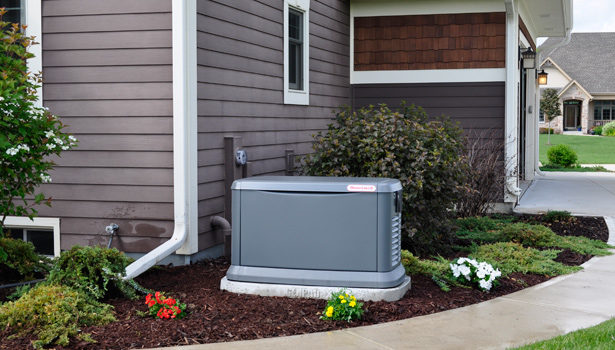As a culture, we often place our eggs in the wrong basket of technology.
We’re confident the most contemporary Doppler radar systems can tell us the details of the next thunderstorm, heat wave, or severe weather. Yet, this high-tech predictor cannot outwit the curveballs weather often throws.
Another technology, the home standby generator, is designed to be reliable in the face of the impossible-to-predict variable weather conditions that often necessitate its use; yet, many homeowners do not utilize this appliance. Home standby generators provide homeowners reliable backup power to keep them comfortable, safe, and secure during a power outage. With a growing nationwide distribution network and comprehensive customer service solutions, it’s an ideal partnership for installers and homeowners.
If It’s Not Weather, It’s A Squirrel
Homeowners and weather forecasters do their best to be prepared for severe weather. From sump pumps to sealed windows, emergency kits to flashlights, we do our best to anticipate the havoc a storm can bring. This only solves part of the problem, however.
Severe weather is just one of the causes of power outages. According to the American Society of Civil Engineers, our nation’s infrastructure, including its power grid, earns only a D+ rating. The United States’ power grid is more than half a century old and repairs and upgrades can amount to more than $2 trillion to make the grid reliable.
So the next time a squirrel is trapped in a transformer, homeowners may see the lights go out. What’s troubling and what so few are prepared for, is that bringing power back can take longer than expected. Old equipment in ill-repair requires more attention to be brought back to working order.
When having the power on means having heat in the winter, refrigeration for your groceries, or air conditioning during a heat wave, timing is essential.
A Digital Life Demands More Power
Today’s power outages don’t measure up to the nostalgia of family night board games by candlelight or flashlight tag in the living room. Longer, more frequent outages and increasingly more severe storms mean that a household without power is also without many more contemporary essentials.
As more homeowners leave behind a home phone in lieu of cellular communication, phones in an emergency are solely reliant on power. If the power is out, so are chargers, tablets, DVRs, smart TVs, and any multimedia tools that have come to represent modern living. Want to hop on the Internet from a charged laptop computer to track the storm? Not if you rely on a wireless internet connection. Power’s out, router’s out.
Solutions Made Simple
Currently, it’s estimated that less than 3 percent of American households have home standby generators installed, so this is an enormous market opportunity. Home standby generators are an attractive option for homeowners looking for the security of reliable power no matter what. An automatic backup generator turns on within seconds of the power going out, and when the return of utility power is sensed, it automatically shuts down and returns to standby mode, ready for the next outage. The confidence a generator gives homeowners translates into an attractive business opportunity for HVAC contractors as the need for power grows.
Generator lines, like premium brand Honeywell, often offer expansive ranges of sizes and transfer switches, giving homeowners options when it comes to backup power. Installers can size homes and coach homeowners to backup a furnace, central air, refrigerator — or backup every circuit in the house thanks to the broad range of generator sizes available. The generator and transfer switch work together to monitor utility power 24/7. Homeowners don’t need to be available to start the system in the event of an outage — it will start automatically. The generator sits outside the home or business just like a central air conditioner, while the transfer switch is located next to the main breaker box.
Knowledge About Power Is Power
Other conveniences have been added to many generator packages to add to their ease of use and value for the homeowner. For example, Mobile Link cellular remote monitoring, offered standard in Honeywell generators and as an option for all Generac home standby generators, lets you get and share information about your home standby generator no matter where you are, using your computer, smart phone, or mobile device. You can view your generator’s status and maintenance needs, set its exercise schedule, review its running and maintenance history, and get notified of status changes.
When the generator experiences a change in status, Mobile Link sends an update to MobileLinkGen.com, which forwards that information via website, email, or text message — automatically.
Mobile Link’s cellular-based technology offers advantages over existing alternatives:
• Ethernet or telephone connection-based solutions require uninterrupted utility power.
• Low cost cellular solution.
• Cellular technology provides broad coverage nationwide.
• Cellular network self-configuration eliminates complicated set-up and maintenance.
• Installs in less than 15 minutes and is easy to use.
• OEM design for reliability and accuracy.
Premium Options for Premium Power
Home standby generators can be quiet and are reliable. Many offer self-test options and indicate to homeowners when maintenance is required. Some units are designed with panels and shell features that offer sound-reducing elements, providing additional noise reduction.
This appliance is easy to maintain as well. The generator runs on a home's existing natural gas or LP fuel supply. Both easily meet U.S. Environmental Protection Agency (EPA) clean air standards, don't face the spilling or storage issues of diesel, and are in continuous supply. That means a home’s generator will run as long as necessary — until utility power is restored.
Home standby generators, always installed on the exterior of the home, come in various materials, but premium models may offer aluminum enclosures better suited to withstand high winds. There are also installation standards from the National Fire Protection Association (NFPA) that regulate the distance between the home and the generator’s footprint and different brands are equipped to be installed as close as 18 inches from the home.
Full Service Home Service
Homeowners recognize the utility of a central air conditioning unit in the summer and the need for a functioning furnace in winter. These are the talking points of the HVAC industry. What isn’t discussed enough, however, is how to keep the air conditioning and the furnace running when the power’s out. A home standby generator will provide that conversation starter and the solution.
Publication date: 3/9/2015
Want more HVAC industry news and information? Join The NEWS on Facebook, Twitter, and LinkedIn today!











